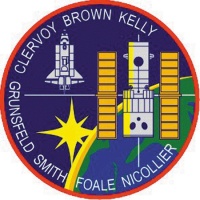STS-103
From The Space Library
 | |
| Organization | NASA-Office of Space Flight (United States) |
|---|---|
| Mission type | Human Crew,Resupply/Refurbishment/Repair |
| Launch date | December 20, 1999 |
| Launch vehicle | Space Shuttle |
| Launch site | Cape Canaveral, United States |
| COSPAR ID | 1999-069A |
| Inclination | 28.45 degrees |
| Experiments | Here |
| Alternate Names | 25996 |
| Additional Information | Here |
| Data Collection | Here |
| Payload Mass Up | 5991.04 kg |
| Payload Mass Down | 5970.91 kg |
| Orbiter | Discovery |
| Lift Off Mass | 2,048,372.27 kg |
| Orbiter Weight at Liftoff | 112,799.55 kg |
| Orbiter Weight at Landing | 95,898.64 kg |
| Landed | Concrete runway 33 at Kennedy Space Center, Fla. |
| Orbits of Earth | 120 |
| Orbital Altitude | 317 nautical miles (365 statute miles) |
Contents |
[edit] Crew
- Commander: Curtis L. Brown
- Pilot: Scott J. Kelly
- Payload Commander:
- Mission Specialist 1: Jean-Francois Clervoy, European Space Agency
- Mission Specialist 2: Steven L. Smith
- Mission Specialist 3: C. Michael Foale
- Mission Specialist 4: John M. Grunsfeld
- Mission Specialist 5: Claude Nicollier, European Space Agency
- Payload Specialist 1:
- Payload Specialist 2:
ISS/Mir Crew Transport
[edit] Mission
STS 103 was an American shuttle spacecraft launched from Cape Canaveral at 00:50 UT, after nine cancellations of earlier attempts during the month. The main mission was to repair the inoperational Hubble spacecraft: replace all six gyroscopes, including the four recently failed ones (that engendered total shut down since 13 November 1999), replace its computer system, replace the voltage and temperature controls on its battery packs, and install an additional onboard data recorder of 12 gigabyte capacity. Replacement of the degraded exterior insulation on Hubble entailed a few hours of EVAs by the crew. This was the third repair mission to Hubble; the earlier ones were during December 1993 (STS 61), and February 1997 (STS 82). (The shuttle also carried a disk containing posters that were autographed by hundreds of thousands of elementary school children.) It landed back at Cape Canaveral on 28 December at 00:01 UT, after successfully completing the eight day mission..
[edit] EVA
Extravehicular Activity (EVA) conducted by Steven Smith, John Grunsfeld, Michael Foale, and Claude Nicollier during three spacewalks for a total of 24 hours, 33 minutes. EVA 1, Smith and Grunsfeld, 8 hours, 15 minutes; Smith and Grunsfeld installed six new gyroscopes and six voltage/temperature improvement kits in the telescope. EVA 2, Foale and Nicollier, 8 hours, 10 minutes; Foale and Nicollier installed a new advanced computer, 20 times faster and with six times the memory of the previous machine, and replaced a 550-pound fine guidance sensor, one of three on the telescope. EVA 3, Smith and Grunsfeld, 8 hours, 8 minutes; Smith and Grunsfeld replaced a failed radio transmitter and installed a new digital solid-state recorder that will provide more than 10 times the storage capacity of the old unit. They also applied new insulation on two equipment bay doors. Both the transmitter and the recorder checked out normally on early tests by telescope controllers.
[edit] Payload
Hubble Space Telescope servicing mission 03-A (fine guidance sensor; gyroscopes; new advanced computer; new thermal blanket layers; S-band single-access transmitter; solid-state recorder; and voltage/temperature improvement kits)
[edit] Books about the Space Shuttle Program
Buy This Book Click here |
Buy This Book here |
Buy This Book Click here |
Buy This Book Click here |





